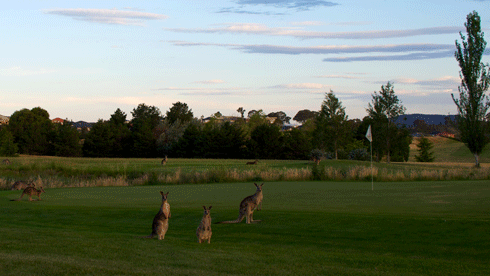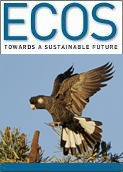
|
Published: 3 June 2013
Golf courses as refuges?
Are golf courses the next big thing for urban biodiversity conservation? New research from the University of Technology Sydney (UTS) aims to answer that question.

|
|
Kangaroos on the Gold Creek golf course, Nicholls, ACT. Credit:
neofito via flickr under CC BY 2.0
|
As the clearing of native vegetation and increasing urbanisation threaten biodiversity through habitat loss and fragmentation, areas of land outside of the formal reserve system are vitally important for preserving biodiversity.
A few studies have shown that well-designed and managed golf courses can play a role in restoring and enhancing biodiversity. They provide large expanses of green open space and they can also support a range of different habitats such as woodlands, grasslands, heathlands, scrub, wetlands and water features on their rough and out-of-play areas.
These different habitats provide wildlife with food, water, breeding sites and protection from predators. So, apart from providing a recreational benefit, golf courses can provide critical ecosystem services, such as improved local water quality, pollination and carbon sequestration.
Management that enhances biodiversity on golf courses can also lower maintenance costs by reducing mowing, pesticide, fertiliser and water usage; provide natural wind breaks; even out temperature fluctuations; and provide more attractive and better quality courses.
UTS’s Institute for Sustainable Futures has just completed research for the Hawkesbury Nepean Catchment Management Authority (HNCMA) to determine the factors that support and constrain the adoption of improved practices on golf courses in the greater Sydney region, with particular reference to biodiversity, habitat and carbon storage.
The project will assist the HNCMA and Golf NSW to formulate effective investment and support programs for building the capacity of golf course personnel to improve biodiversity practices.
The research team conducted a workshop and an online survey of golf course superintendents, staff and club managers from across the Sydney metropolitan region.
The research found that more than half the golf clubs surveyed contain endangered ecological communities or threatened species.
Most of the golf course personnel that took part in the survey believe that managing biodiversity on golf courses is important, agree that biodiversity enhances the experience of playing on a golf course, and had taken some action towards improving the management of biodiversity on their course.
The study also found considerable variation in capacity to manage biodiversity on golf courses and identified barriers to improved management that included financial constraints on golf club operations and the complexity of relationships with the large number of stakeholders that have an influence on course management.
Despite the financial constraints, the majority of clubs were unaware of, or had not accessed, external grant funding to undertake environmental works.
The report on the study makes a series of recommendations to build the capacity of golfing associations, golf clubs, and state government agencies to enhance and protect biodiversity on golf courses. The Teeing-off Carbon Connections project is supported by the Australian Government’s Clean Energy Future Biodiversity Fund.
Source: UTS



